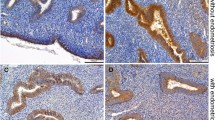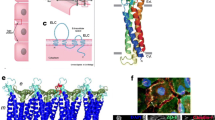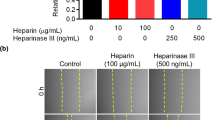Abstract
Implantation of the mammalian embryo requires profound endometrial changes for successful pregnancy, including epithelial–mesenchymal transition of the luminal epithelium and stromal–epithelial transition of the stromal cells resulting in decidualization. Claudins (Cldn) determine the variability in tight junction paracellular permeability and may play a role during these epithelial and decidual changes. We here localized Cldn3, Cldn7 and Cldn10 proteins in the different compartments of murine endometrium up to day 8.5 of pregnancy (dpc) as well as in human endometrium and first trimester decidua. In murine estrous endometrium, luminal and glandular epithelium exhibited Cldn3 and Cldn7, whereas Cldn10 was only detectable in glandular epithelium. At 4.5 dpc, Cldn3 protein shifted to an apical localization, whereas Cldn7 vanished in the epithelium of the implantation chamber. At this stage, there was no stromal signal for Cldn3 and Cldn7, but a strong induction of Cldn10 in the primary decidual zone. Cldn3 proteins emerged at 5.5 dpc spreading considerably from 6.5 dpc onward in the endothelial cells of the decidual blood sinusoids and in the decidual cells of the compact antimesometrial region. In addition to Cldn3, Cldn10 was identified in human endometrial epithelia. Both proteins were not detected in human first trimester decidual cells. Cldn3 was shown in murine trophoblast giant cells as well as in human extravillous trophoblast cells and thus may have an impact on trophoblast invasion in both species. We here showed a specific claudin signature during early decidualization pointing to a role in decidual angiogenesis and regulation of trophoblast invasion.






Similar content being viewed by others
References
Abuazza G, Becker A, Williams SS, Chakravarty S, Truong HT, Lin F, Baum M (2006) Claudins 6, 9, and 13 are developmentally expressed renal tight junction proteins. Am J Physiol Ren Physiol 291(6):F1132–F1141
Amasheh S, Fromm M, Günzel D (2011) Claudins of intestine and nephron—a correlation of molecular tight junction structure and barrier function. Acta Physiol 201(1):133–140
Blankenship TN, Given RL (1992) Penetration of the uterine epithelial basement membrane during blastocyst implantation in the mouse. Anat Rec 233:196–204
Buck VU, Windoffer R, Leube RE, Classen-Linke I (2012) Redistribution of adhering junctions in human endometrial epithelial cells during the implantation window of the menstrual cycle. Histochem Cell Biol 137(6):777–790
Carson DD, Bagchi I, Dey SK, Enders AC, Fazleabas AT, Lessey BA, Yoshinaga K (2000) Embryo implantation. Dev Biol 223(2):217–237
Cha J, Sun X, Dey SK (2012) Mechanisms of implantation: strategies for successful pregnancy. Nat Med 18(12):1754–1767. doi:10.1038/nm.3012
Collins MM, Baumholtz AI, Simard A, Gregory M, Cyr DG, Ryan AK (2015) Claudin-10 is required for relay of left-right patterning cues from Hensen’s node to the lateral plate mesoderm. Dev Biol. doi:10.1016/j.ydbio.2015.02.019
Cross JC, Hemberger M, Lu Y, Nozaki T, Whiteley K, Masutani M, Adamson SL (2002) Trophoblast functions, angiogenesis and remodeling of the maternal vasculature in the placenta. Mol Cell Endocrinol 187(1–2):207–212
Croy BA, Chen Z, Hofmann AP, Lord EM, Sedlacek AL, Gerber SA (2012) Imaging of vascular development in early mouse decidua and its association with leukocytes and trophoblasts. Biol Reprod 87(5):125
Damsky CH, Fisher SJ (1998) Trophoblast pseudo-vasculogenesis: faking it with endothelial adhesion receptors. Curr Opin Cell Biol 10(5):660–666
Das A, Mantena SR, Kannan A, Evans DB, Bagchi MK, Bagchi IC (2009) De novo synthesis of estrogen in pregnant uterus is critical for stromal decidualization and angiogenesis. Proc Natl Acad Sci USA 106(30):12542–12547
Denker HW (1994) Cell Biology of endometrial receptivity and of trophoblast-endometrial interactions. In: Glasser SR, Mulholland J, Psychoyos A (eds) Endocrinology of Embryo-Endometrium Interactions. Plenum Press, New York, pp 17–32
Dhawan P, Singh AB, Deane NG, No Y, Shiou SR, Schmidt C, Neff J, Washington MK, Beauchamp RD (2005) Claudin-1 regulates cellular transformation and metastatic behavior in colon cancer. J Clin Investig 115(7):1765–1776
Ding L, Lu Z, Foreman O, Tatum R, Lu Q, Renegar R, Cao J, Chen YH (2012) Inflammation and disruption of the mucosal architecture in claudin-7-deficient mice. Gastroenterology 142:305–315
Enders AC (2008) Trophoblast-uterine interactions in the first days of implantation: models for the study of implantation events in the human. Semin Reprod Med 18(3):255–263
Enders AC, Schlafke S (1969) Cytological aspects of trophoblast-uterine interaction in early implantation. Am J Anat 125(1):1–29
Escudero-Esparza A, Jiang WG, Martin TA (2011) The Claudin family and its role in cancer and metastasis. Front Biosci 16:1069–1083
Fanning AS, Jameson BJ, Jesaitis LA, Anderson JM (1998) The tight junction protein ZO-1 establishes a link between the transmembrane protein occludin and the actin cytoskeleton. J Biol Chem 273(45):29745–29753
Fernández-Blanco JA, Estévez J, Shea-Donohue T, Martínez V, Vergara P (2015) Changes in epithelial barrier function in response to parasitic infection: implications for IBD pathogenesis. J Crohns Colitis. doi:10.1093/ecco-jcc/jjv056
French AD, Fiori JL, Camilli TC, Leotlela PD, O’Connell MP, Frank BP, Subaran S, Indig FE, Taub DD, Weeraratna AT (2009) PKC and PKA phosphorylation affect the subcellular localization of claudin-1 in melanoma cells. Int J Med Sci 6:93–101
Fujita H, Chiba H, Yokozaki H, Sakai N, Sugimoto K, Wada T, Kojima T, Yamashita T, Sawada N (2006) Differential expression and subcellular localization of claudin-7, -8, -12, -13, and -15 along the mouse intestine. J Histochem Cytochem 54(8):933–944
Furuse M, Sasaki H, Tsukita S (1999) Manner of interaction of heterogeneous claudin species within and between tight junction strands. J Cell Biol 147:891–903
Gaetje R, Holtrich U, Engels K, Kissler S, Rody A, Karn T, Kaufmann M (2008) Differential expression of claudins in human endometrium and endometriosis. Gynecol Endocrinol 24(8):442–449
Gellersen B, Brosens J (2003) Cyclic AMP and progesterone receptor cross-talk in human endometrium: a decidualizing affair. J Endocrinol 178(3):357–372
Gellersen B, Brosens JJ (2014) Cyclic decidualization of the human endometrium in reproductive health and failure. Endocr Rev 35(6):851–905
Gellersen B, Brosens IA, Brosens JJ (2007) Decidualization of the human endometrium: mechanisms, functions, and clinical perspectives. Semin Reprod Med 25(6):445–453
Gonzalez-Mariscal L, Namorado Mdel C, Martin D, Sierra G, Reyes JL (2006) The tight junction proteins claudin-7 and -8 display a different subcellular localization at Henle’s loops and collecting ducts of rabbit kidney. Nephrol Dial Transplant 21(9):2391–2398
González-Mariscal L, Domínguez-Calderón A, Raya-Sandino A, Ortega-Olvera JM, Vargas-Sierra O, Martínez-Revollar G (2014) Tight junctions and the regulation of gene expression. Semin Cell Dev Biol 36:213–223. doi:10.1016/j.semcdb.2014.08.009
Gottardi CJ, Arpin M, Fanning AS, Louvard D (1996) The junction-associated protein, zonula occludens-1, localizes to the nucleus before the maturation and during the remodeling of cell-cell contacts. Proc Natl Acad Sci USA 93(20):10779–10784
Grümmer R, Hewitt SW, Traub O, Korach KS, Winterhager E (2004) Different regulatory pathways of endometrial connexin expression: preimplantation hormonal-mediated pathway versus embryo implantation-initiated pathway. Biol Reprod 71(1):273–281
Guillemot L, Paschoud S, Pulimeno P, Foglia A, Citi S (2008) The cytoplasmic plaque of tight junctions: a scaffolding and signalling center. Biochim Biophys Acta 1778(3):601–613. doi:10.1016/j.bbamem.2007.09.032
Gupta IR, Ryan AK (2010) Claudins: unlocking the code to tight junction function during embryogenesis and in disease. Clin Genet 77(4):314–325
Gusti V, Bennett KM, Lo DD (2014) CD137 signaling enhances tight junction resistance in intestinal epithelial cells. Physiol Rep 2(8):e12090. doi:10.14814/phy2.12090
Hay ED (1995) An overview of epithelio-mesenchymal transformation. Acta Anat 154(1):8–20
Heiskala M, Peterson PA, Yang Y (2001) The roles of claudin superfamily proteins in paracellular transport. Traffic 2(2):93–98
Inai T, Sengoku A, Hirose E, Iida H, Shibata Y (2007) Claudin-7 expressed on lateral membrane of rat epididymal epithelium does not form aberrant tight junction strands. Anat Rec 290(11):1431–1438
Islas S, Vega J, Ponce L, Gonzalez-Mariscal L (2002) Nuclear localization of the tight junction protein ZO-2 in epithelial cells. Exp Cell Res 274:138–148
Itoh M, Furuse M, Morita K, Kubota K, Saitou M, Tsukita S (1999) Direct binding of three tight junction-associated MAGUKs, ZO-1, ZO-2, and ZO-3, with the COOH termini of claudins. J Cell Biol 147(6):1351–1363
Iwanaga S, Inokuchi T, Notohara A, Higashi R, Murakami M, Kato T (1985) Alterations in tight junctions of human endometrial epithelial cells during normal menstrual cycle–freeze-fracture electron microscopic study. Nihon Sanka Fujinka Gakkai Zasshi 37(12):2847–2852
Joswig A, Gabriel HD, Kibschull M, Winterhager E (2003) Apoptosis in uterine epithelium and decidua in response to implantation: evidence for two different pathways. Reprod Biol Endocrinol 1:44. doi:10.1186/1477-7827-1-44
Kim M, Park HJ, Seol JW, Jang JY, Cho YS, Kim KR, Choi Y, Lydon JP, Demayo FJ, Shibuya M, Ferrara N, Sung HK, Nagy A, Alitalo K, Koh GY (2013) VEGF-A regulated by progesterone governs uterine angiogenesis and vascular remodelling during pregnancy. EMBO Mol Med 5(9):1415–1430
Kooij G, Kopplin K, Blasig R, Stuiver M, Koning N, Goverse G, van der Pol SM, van Het Hof B, Gollasch M, Drexhage JA, Reijerkerk A, Meij IC, Mebius R, Willnow TE, Müller D, Blasig IE, de Vries HE (2014) Disturbed function of the blood-cerebrospinal fluid barrier aggravates neuro-inflammation. Acta Neuropathol 128(2):267–277
Krause G, Winkler L, Mueller SL, Haseloff RF, Piontek J, Blasig IE (2008) Structure and function of claudins. Biochim Biophys Acta 1778(3):631–645
Lal-Nag M, Morin PJ (2009) The claudins. Genome Biol 10:235.1-235.7
Liang X, Zhang XH, Han BC, Lei W, Qi QR, Wang TS, Gu XW, Yang ZM (2013) Progesterone and heparin-binding epidermal growth factor-like growth factor regulate the expression of tight junction protein Claudin-3 during early pregnancy. Fertil Steril 100(5):1410–1418. doi:10.1016/j.fertnstert.2013.07.001
Lu Z, Kim do H, Fan J, Lu Q, Verbanac K, Ding L, Renegar R, Chen YH (2015) A non-tight junction function of claudin-7-Interaction with integrin signaling in suppressing lung cancer cell proliferation and detachment. Mol Cancer 14(1):120. doi:10.1186/s12943-015-0387-0
Lydon JP, DeMayo FJ, Funk CR, Mani SK, Hughes AR, Montgomery CA Jr, Shyamala G, Conneely OM, O’Malley BW (1995) Mice lacking progesterone receptor exhibit pleiotropic reproductive abnormalities. Genes Dev 9(18):2266–2278
Mendoza-Rodriguez CA, Gonzalez-Mariscal L, Cerbon M (2005) Changes in the distribution of ZO-1, occludin, and claudins in the rat uterine epithelium during the estrous cycle. Cell Tissue Res 319:315–330
Morita K, Furuse M, Fujimoto K, Tsukita S (1999) Claudin multigene family encoding four-transmembrane domain protein components of tight junction strands. Proc Natl Acad Sci USA 96(2):511–516
Murphy CR (2000) Junctional barrier complexes undergo major alterations during the plasma membrane transformation of uterine epithelial cells. Hum Reprod 15:182–188
Murphy CR (2004) Uterine receptivity and the plasma membrane transformation. Cell Res 14:259–267
Nicholson MD, Lindsay LA, Murphy CR (2010) Ovarian hormones control the changing expression of claudins and occludin in rat uterine epithelial cells during early pregnancy. Acta Histochem 112(1):42–52
Nikas G, Drakakis P, Loutradis D, Mara-Skoufari C, Koumantakis E, Michalas S, Psychoyos A (1995) Uterine pinopodes as markers of the ‘nidation window’ in cycling women receiving exogenous oestradiol and progesterone. Hum Reprod 10(5):1208–1213
Noyes RW, Hertig AT, Rock J (1950) Dating the endometrial biopsy. Fertil Steril 1:3–25
Orchard MD, Murphy CR (2002) Alterations in tight junction molecules of uterine epithelial cells during early pregnancy in the rat. Acta Histochem 104:149–155
Pan XY, Wang B, Che YC, Weng ZP, Dai HY, Peng W (2007) Expression of claudin-3 and claudin-4 in normal, hyperplastic, and malignant endometrial tissue. Int J Gynecol Cancer 17(1):233–241
Pan XY, Li X, Weng ZP, Wang B (2009) Altered expression of claudin-3 and claudin-4 in ectopic endometrium of women with endometriosis. Fertil Steril 91(5):1692–1699
Paria BC, Zhao X, Das SK, Dey SK, Yoshinaga K (1999) Zonula occludens-1 and E-cadherin are coordinately expressed in the mouse uterus with the initiation of implantation and decidualization. Dev Biol 208(2):488–501
Parr MB, Parr EL (1986) Permeability of the primary decidual zone in the rat uterus: studies using fluorescein-labeled proteins and dextrans. Biol Reprod 34(2):393–403
Poon CE, Madawala RJ, Day ML, Murphy CR (2013) Claudin 7 is reduced in uterine epithelial cells during early pregnancy in the rat. Histochem Cell Biol 139(4):583–593
Ramathal CY, Bagchi IC, Taylor RN, Bagchi MK (2010) Endometrial decidualization: of mice and men. Semin Reprod Med 28(1):17–26. doi:10.1055/s-0029-1242989
Reichert M, Muller T, Hunziker W (2000) The PDZ domains of zonula occludens-1 induce an epithelial to mesenchymal transition of Madin-Darby canine kidney I cells. Evidence for a role of beta-catenin/Tcf/Lef signaling. J Biol Chem 275(13):9492–9500
Riesewijk A, Martín J, van Os R, Horcajadas JA, Polman J, Pellicer A, Mosselman S, Simón C (2003) Gene expression profiling of human endometrial receptivity on days LH + 2 versus LH + 7 by microarray technology. Mol Hum Reprod 9(5):253–264
Rogers PA, Murphy CR, Rogers AW, Gannon BJ (1983) Capillary patency and permeability in the endometrium surrounding the implanting rat blastocyst. Int J Microcirc Clin Exp 2(3):241–249
Saitou M, Furuse M, Sasaki H, Schulzke JD, Fromm M, Takano H, Noda T, Tsukita S (2000) Complex phenotype of mice lacking occludin, a component of tight junction strands. Mol Biol Cell 11:4131–4142
Sarani SA, Ghaffari-Novin M, Warren MA, Dockery P, Cooke ID (1999) Morphological evidence for the ‘implantation window’ in human luminal endometrium. Hum Reprod 14(12):3101–3106
Schneeberger EE, Lynch RD (2004) The tight junction: a multifunctional complex. Am J Physiol Cell Physiol 286:C1213–C1228
Schröder K (2013) Generierung und Charakterisierung eines Claudin-3-defizienten Mausmodells. Dissertation, Humboldt-Universität zu Berlin
Serafini PC, Silva ID, Smith GD, Motta EL, Rocha AM, Baracat EC (2009) Endometrial claudin-4 and leukemia inhibitory factor are associated with assisted reproduction outcome. Reprod Biol Endocrinol 7:30
Sharkey AM, Smith SK (2003) The endometrium as a cause of implantation failure. Best Pract Res Clin Obstet Gynaecol 17(2):289–307
Simard A, Di Pietro E, Ryan AK (2005) Gene expression pattern of Claudin-1 during chick embryogenesis. Gene Expr Pattern 5:553–560
Sobel G, Nemeth J, Kiss A, Lotz G, Szabo I, Udvarhelyi N, Schaff Z, Paska C (2006) Claudin 1 differentiates endometrioid and serous papillary endometrial adenocarcinoma. Gynecol Oncol 103:591–598
Someya M, Kojima T, Ogawa M, Ninomiya T, Nomura K, Takasawa A, Murata M, Tanaka S, Saito T, Sawada N (2013) Regulation of tight junctions by sex hormones in normal human endometrial epithelial cells and uterus cancer cell line Sawano. Cell Tissue Res 354(2):481–494
Tan J, Raja S, Davis MK, Tawfik O, Dey SK, Das SK (2002) Evidence for coordinated interaction of cyclin D3 with p21 and cdk6 in directing the development of uterine stromal cell decidualization and polyploidy during implantation. Mech Dev 111:99–113
Torry DS, Leavenworth J, Chang M, Maheshwari V, Groesch K, Ball ER, Torry RJ (2007) Angiogenesis in implantation. J Assist Reprod Genet 24(7):303–315
Troy TC, Arabzadeh A, Yerlikaya S, Turksen K (2007) Claudin immunolocalization in neonatal mouse epithelial tissues. Cell Tissue Res 330(2):381–388
Tsukita S, Furuse M (2000) The structure and function of claudins, cell adhesion molecules at tight junctions. Ann N Y Acad Sci 915:129–135
Tsukita S, Furuse M, Itoh M (2001) Multi-functional strands in tight junctions. Nat Rev Mol Cell Biol 2:285–293
Turksen K, Troy TC (2004) Barriers built on claudins. J Cell Sci 117:2435–2447
Turksen K, Troy TC (2011) Junctions gone bad: claudins and loss of the barrier in cancer. Biochim Biophys Acta 1816:73–79
Van Itallie CM, Anderson JM (2014) Architecture of tight junctions and principles of molecular composition. Semin Cell Dev Biol 36:157–165
Wang X, Matsumoto H, Zhao X, Das SK, Paria BC (2004) Embryonic signals direct the formation of tight junctional permeability barrier in the decidualizing stroma during embryo implantation. J Cell Sci 117(Pt 1):53–62
Wolburg H, Wolburg-Buchholz K, Kraus J, Rascher-Eggstein G, Liebner S, Hamm S, Duffner F, Grote EH, Risau W, Engelhardt B (2003) Localization of claudin-3 in tight junctions of the blood-brain barrier is selectively lost during experimental autoimmune encephalomyelitis and human glioblastoma multiforme. Acta Neuropathol 105(6):586–592
Xia P, Wang W, Bai Y (2014) Claudin-7 suppresses the cytotoxicity of TRAIL-expressing mesenchymal stem cells in H460 human non-small cell lung cancer cells. Apoptosis 19(3):491–505. doi:10.1007/s10495-013-0938-z
Zhang XH, Liang X, Liang XH, Wang TS, Qi QR, Deng WB, Sha AG, Yang ZM (2013) The mesenchymal-epithelial transition during in vitro decidualization. Reprod Sci 20(4):354–360
Zihni C, Balda MS, Matter K (2014) Signalling at tight junctions during epithelial differentiation and microbial pathogenesis. J Cell Sci 127(16):3401–3413. doi:10.1242/jcs.145029
Zimmerli SC, Hauser C (2007) Langerhans cells and lymph node dendritic cells express the tight junction component claudin-1. J Investig Dermatol 127(10):2381–2390
Acknowledgments
The authors thank Dr. Ulrike von Rango, Maastricht University, for providing human first trimester placentas.
Author information
Authors and Affiliations
Corresponding author
Ethics declarations
Conflict of interest
The authors declare that they have no conflict of interest.
Ethical approval
All applicable international, national and/or institutional guidelines for the care and use of animals were followed. All procedures performed in studies involving animals were in accordance with the ethical standards of the institution or practice at which the studies were conducted.
Informed consent
All procedures performed in studies involving human participants were in accordance with the ethical standards of the institutional and/or national research committee and with the 1964 Helsinki Declaration and its later amendments or comparable ethical standards. Informed consent was obtained from all individual participants included in the study.
Rights and permissions
About this article
Cite this article
Schumann, S., Buck, V.U., Classen-Linke, I. et al. Claudin-3, claudin-7, and claudin-10 show different distribution patterns during decidualization and trophoblast invasion in mouse and human. Histochem Cell Biol 144, 571–585 (2015). https://doi.org/10.1007/s00418-015-1361-z
Accepted:
Published:
Issue Date:
DOI: https://doi.org/10.1007/s00418-015-1361-z




